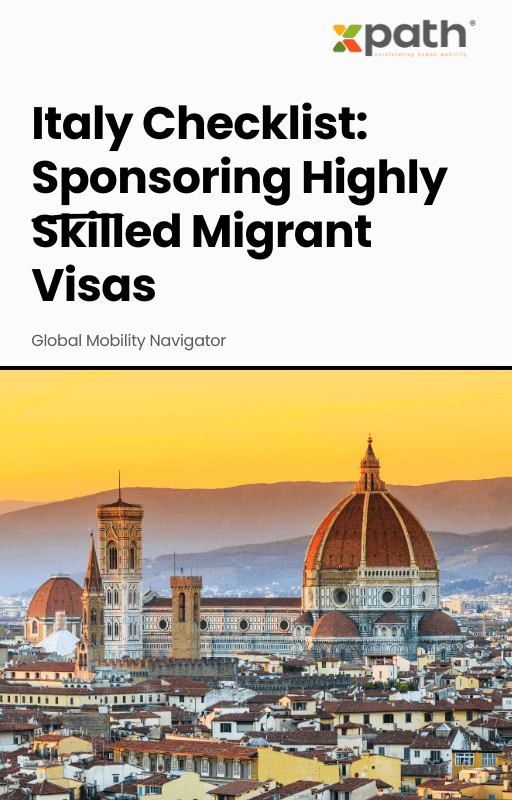Italy Checklist: Sponsoring Highly Skilled Migrant Visas
Grab a copy of a guide to international employee relocation
View E-book
Manage, track and optimize internal operations for increased efficiency of process workflow.
Gain dedicated consultants to manage your global mobility needs.
track and control assignment-related expenses for efficient budget management.
Gain insights and make informed decisions through this comprehensive feature.
Centralize expatriate information for efficient tracking, compliance, and editing.
Secure portals for uploading, storing, and managing necessary documents such as contracts, visas, and work permits.
Network of vetted suppliers offering over 60,000 mobility services across 183 countries.
track and control assignment-related expenses for efficient budget management.
Simplifies document requests and secure sharing for seamless collaboration for all stakeholders
Manage and streamline supplier deliverables for optimal performance and collaboration
Keep track of your assignment duration and length of stay in host country to support tax returns
Visa and Work Permit Processing
Comprehensive Support for Every Assignment Type
Short-Term & Long-Term Accommodations
Compliant Immigration and Visa Services
Assistance With Corporate Relocation Taxes & Social Security
Take control of your visa and immigration challenges today.
Ensure your departures are handled with care and precision.
Let our Advisory Services drive positive change in your organization.
Let us handle your immigration compliance needs while you focus on your core business.

Relocation
April 21, 2022 | xpath.global
The articles on long-term international mobility of apprentices in Europe, written by Cedefop’s ReferNet network, are part of the Cedefop ReferNet thematic perspectives series. These articles complement other available general information on vocational education and training (VET) systems by country. They aim to identify potential enablers and disablers of long-term cross-country mobility for apprentices at two levels: framework level (external factors to apprenticeships) and apprenticeship system/scheme design level.
At the framework level, the articles explore external factors influencing apprenticeship mobility, while at the design level, they examine the structure of apprenticeship systems. Where possible, the articles also aim to identify successful and unsuccessful policies, initiatives, and projects regarding the international mobility of apprentices. These insights are crucial for understanding what works and what does not at the implementation level.
Increasing apprentices’ participation in cross-country learning mobility has recently become a key policy initiative. In December 2016, the communication ‘Investing in Europe’s Youth’ launched ‘ErasmusPro,’ a policy initiative aimed at increasing long-term mobility abroad for VET learners, including apprentices or recent graduates. Despite these efforts, cross-country mobility in apprenticeships remains a niche phenomenon, particularly long-term mobility.
Cedefop’s ReferNet network members present a set of factors impacting apprentices’ mobility and discuss how these factors may act as enablers or disablers. Therefore, The articles offer valuable insights into the various challenges of implementing these policies in practice. Cedefop’s study on the long-term mobility of apprentices will provide more in-depth evidence to support policy development in this area.
In conclusion, these articles contribute to a better understanding of the complexities involved in facilitating long-term international mobility for apprentices. They highlight both the potential benefits and the obstacles that need to be addressed to make this mobility a more widespread reality.
Source: European Center for the Development of Vocational Training

Italy Checklist: Sponsoring Highly Skilled Migrant Visas
Grab a copy of a guide to international employee relocation
View E-book
